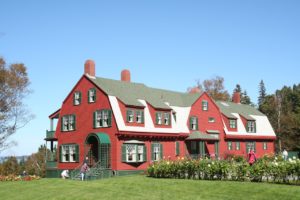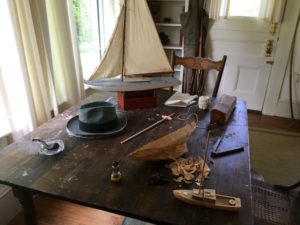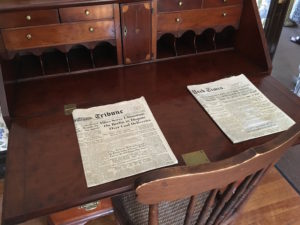One more post about our trip to Maine and I promise we’ll stop.
On our last morning, we packed our bags and headed to Campobello Island, over the border in New Brunswick, Canada. We had a long drive to Boston after Beth’s last workshop session that morning, so we wanted to leave out directly from Campobello.
While Beth was doing writing exercises with her classmates, I took one more walk—this time I headed to the Roosevelt Cottage. Cottage is a bit of a misnomer—the Roosevelt Cottage has dozens of rooms. Yet, because it’s not winterized (and summer only), and because it doesn’t have a basement, it’s called a cottage.

Not bad for a summer place, eh?
The Roosevelt Campobello International Park is operated jointly by the U.S. and Canadian governments, which in itself is novel and heartening. A tour guide was standing in the foyer when I entered and immediately launched into an intro to the substantial history of the cottage, and of the island. The Cliff’s Notes: FDR summered on Campobello Island with his parents as a boy. He learned to sail, fish, and shoot a bow and arrow. In the beginning they stayed in giant luxury hotels, but they eventually built their own places, as did other wealthy families from the Northeastern United States. They’d take the train as far as they could go, then board steamships to the islands.
As the guide talked, a few other people filtered in and joined us before we left for a walk through the cottage. At the first stop, a little nook where FDR carved little boats out of wood, a fedora and pipe sat next to some carving tools. The guide said that the legend is that in 1939, his last visit to the island, FDR left his hat and pipe fully expecting to return.

FDR’s hat and pipe on the left side of the table.
I don’t think I can do the rest of the tour justice. But you’ve probably had that feeling—where you stand where a hero, a legend, once walked and you just feel something. The Park staff has done a marvelous job retaining or reacquiring original furnishings and belongings: There’s Eleanor’s writing desk. The bed where FDR convalesced after polio struck. And that’s the adjacent daybed that Eleanor slept in. The kids rooms, the kitchen. The giant megaphone FDR used to converse with fisherman on the water out front, sometimes asking if they could bring a NY Times back from Eastport, the town visible across the bay.

Eleanor Roosevelt’s writing desk.
The tour guide, who had been raised on Campobello, loved her work. She’d first worked there as a teenager, and she told a story about Franklin and Eleanor’s surviving sons visiting the cottage in 1979, and carrying on the way siblings do: Arguing about accounts of bygone days.
On the one hand, it was inspiring. Franklin and Eleanor Roosevelt and their children were flesh and blood, just like everyone. They survived and led the United States and the world through hardship I can’t fathom. The history of their time was the history of my mother and father’s time, and I draw a straight line between it and my own history. As I walked through I felt proud and awed and hopeful.
But as I left, I couldn’t help thinking: Sorry, we’ve let you down.
Thanks for taking me to the cottage.
All right, now you’ve done it. I have to eat a lobster roll. Do you know how much it’s going to cost me to get a lobster roll shipped to central Illinois?
Thanks Mike
Jean, you can a pretty good one up here at a place called Acadia. If you get here, I’m buying.
Bev, Colleen, thanks for reading and you’re welcome.
If you can get up there, go. And take the cottage tour. 15 minutes.
Makes me think of a book I just finished “The Firebrand and the First Lady” about Eleanor and her friendship with Pauli Murray. A great read. Can’t recall if the cottage figured into in, but nice to hear about it.
Leave a Response